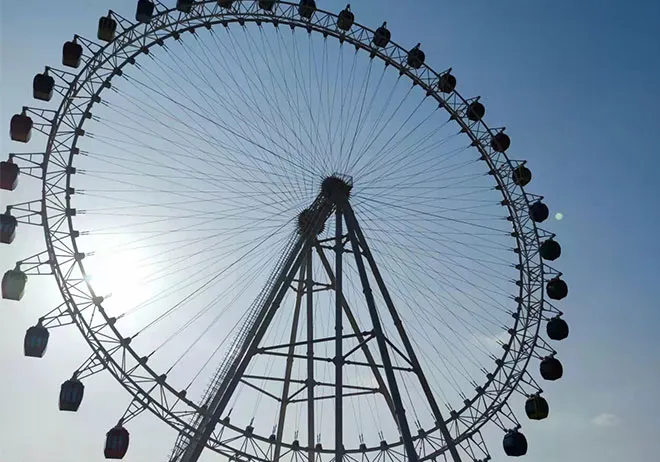- Albanian
- Arabic
- Belarusian
- Bengali
- Czech
- English
- French
- German
- Hebrew
- Hungarian
- Indonesian
- irish
- Italian
- Japanese
- kazakh
- Persian
- Russian
- Thai
- Uzbek
- Vietnamese
90A Spoke Ferris Wheel
Ferris wheels, an iconic attraction in amusement parks and fairs worldwide, continue to captivate people of all ages. However, for businesses and aspiring entrepreneurs interested in acquiring or investing in a ferris wheel, understanding the pricing dynamics is crucial. The cost of a ferris wheel can vary widely based on several factors such as size, materials, design, and additional features. Here, we delve into the various aspects influencing the price of ferris wheels and provide insights to guide your investment decisions effectively.

Firstly, the size of the ferris wheel is a primary determinant of its cost. Smaller ferris wheels, often found in shopping malls or smaller venues, typically range from $300,000 to $600,000. In contrast, larger wheels, similar to the iconic London Eye, can cost upwards of $5 million. The height and passenger capacity directly influence the materials and engineering required, subsequently affecting the overall investment.
The materials used in constructing a ferris wheel significantly impact the price. High-quality steel and glass components not only ensure safety and durability but also add to the cost. Ferris wheels built for harsh weather conditions or those that operate year-round might require additional features such as weather-proof cabins and advanced stabilization technologies, pushing the price higher.

Design intricacy and customization are also pivotal in pricing. Standard ferris wheels often come at a lower cost and are widely available from manufacturers. However, customized designs, which might include unique lighting systems or thematic aesthetics, add substantial value but also increase the price. Many operators justify this extra cost as such features can enhance the visual appeal, thereby attracting more visitors and increasing profitable operations.
Beyond the initial purchase price, operational costs play a significant role. Insurance, maintenance, staffing, and licensing fees should be considered. A well-maintained ferris wheel ensures safety and continued operation, but this requires regular inspections and part replacements, all of which add to the ongoing expenses.
ferris wheel price
Location and installation are logistical components influencing the overall expenditure. Urban areas with limited space or stringent construction regulations may incur higher installation costs. Furthermore, transportation of the ferris wheel to the site can be expensive, particularly for international shipping.
Expertise in operation and maintenance should not be overlooked when considering the total cost of ownership. Firms with highly skilled personnel in ride operations and troubleshooting can prevent expensive downtimes, ensuring the ferris wheel remains a viable revenue-generating attraction.
In terms of trustworthiness, it’s vital to work with reputable manufacturers and suppliers. Thorough research, due diligence, and reference checks are essential to mitigate risks associated with purchasing such a significant asset. Engaging with firms that offer warranties and after-sales support ensures peace of mind and confidence in your investment.
To conclude, purchasing a ferris wheel involves more than just the upfront cost; it’s an investment that requires careful consideration of various factors that contribute to the overall price. By understanding these key components—size, materials, design, operational costs, and supplier credibility—you can make informed decisions that align with your business goals, ensuring the acquisition is both economically sound and operationally efficient.
-
Flume Ride-Hebei Zhipao Amusement Equipment Manufacturing Co., Ltd.|Thrilling Water Attraction&Customizable DesignJul.30,2025
-
Flume Ride - Hebei Zhipao Amusement Equipment | Water Coaster, Thrilling DescentJul.30,2025
-
Flume Ride - Hebei Zhipao | Thrilling Water AttractionJul.30,2025
-
Flume Ride: Thrilling Water Attraction by Hebei Zhipao|Log Flume Manufacturers&Flume Ride DesignJul.30,2025
-
Flume Ride-Hebei Zhipao Amusement Equipment Manufacturing Co., Ltd.|Thrilling Water Coaster, Safe DesignJul.30,2025
-
Flume Ride-Hebei Zhipao Amusement Equipment Manufacturing Co., Ltd.|Thrilling Water Attraction, Safe DesignJul.30,2025
